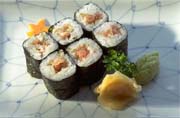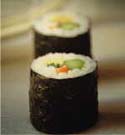|
If you're not already
a sushi fan, you have probably at least heard of, wondered about, or been
intrigued by this unique food. You may have rejected the idea of eating sushi
as too foreign or exotic, and the idea of eating raw fish -
not big in Jewish cuisine- too
far removed from the familiar. But before you exclude this specialty from
your dining pleasure, let me offer some simple explanations of what sushi
is made of, how it is prepared and how the people who do love it feel about
eating it.
Your first sushi
experience will likely be at a sushi bar - special counters that are part
of many Japanese and other Asian restaurants. A quality sushi bar will have
clean, glass enclosed counters where trays of varied and glistening fish
are artfully displayed, along with the other ingredients used by the sushi
chef. These will include a vat of cooked and seasoned rice, sheets of pressed
seaweed (nori), sliced ginger, fresh vegetables, along with a collection
of surgically sharpened knives. Diners sit at the bar in front of this counter
and watch the amazing display of culinary prowess as the sushi chef performs
his art before their eyes.
 |
The process by which
these ingredients become sushi and its counterpart, sashimi is sometimes
entertaining, always precise and usually riveting. The results are beautiful.
These are no less that food served as art forms, with magical blends of texture,
color and flavor.
Sushi can be ordered
in one of three traditional forms: Nigiri, which are small slices of raw
fish served on tiny pillows of rice; Temaki - cones made of pressed seaweed
wrapped around fish, rice and vegetables , and Maki - which resemble fat
rolled cigars formed by spreading fish, rice and vegetables on seaweed sheets,
rolling them and cutting into bite-size pieces. Sashimi are select pieces
of fish, beautifully arranged, served without rice. One can order individual
makis, nigiri, temakis and pieces of sashimi, or combinations thereof.
The small wooden
cutting board on which it arrives will hold pieces of ginger (gari) and mounds
of a fiery green Japanese horseradish (wasabe). The ginger is used to clean
your palate between pieces so that you can savor the unique flavor of each
sushi type. The wasabe should be mixed with soy sauce in your favorite proportions
- also provided to each diner-as the perfect sushi-enhancing condiment.
 |
The presentation
of the sushi is almost ceremonial. It will be decorated with beautifully
and intricately cut vegetables, or presented in exquisite patterns. The result
is food that is almost too beautiful to eat. You will be furnished with both
chopsticks and regular silverware, with which you may dip your pieces of
sushi or sashimi into your soy sauce mixture. You may then proceed to enjoy
your sushi.
What can't be described
without tasting, are the exquisite flavors of these delicacies. The fish
used by sushi chefs are extremely fresh and usually available only to professional
cooks. They are morsels of shining, silken fish that literally melt in your
mouth. Your sushi may be created from mouth-watering salmon, creamy yellowtail,
or succulent fresh tuna. When combined with slightly tangy rice, crisp seaweed,
some cucumber strands or avocado chunks and seasoned with a dollop of soy
sauce and a lick of wasabe, you will have a masterpiece. There's a reason
for the ever-present blissful look on the face of sushi devotees, and why
despite its often-exorbitant cost, the number of sushi fanatics is skyrocketing.
If the idea of raw
fish puts you off, there are countless variations of vegetarian sushi. These
use not only standard vegetables but may include pickled Japanese condiments
or tamago - a kind of sweet folded omelette. There is also sushi that is
made of parts of cooked fish such as broiled salmon skin. This is a crisp
delight, and fantastic when paired with avocado and scallion in a temaki
handroll.
Some more innovative
restaurants have devised sushi that is itself cooked such as the tempura
handrolls offered at. Yakimotoo. The beauty and creativity of these dishes
is limited only by the chef's imagination. One of the most exquisite sushi
handrolls I've seen was composed almost entirely of vegetables and wrapped
in the sheerest wrapper of carrot. I never even missed the fish. Non-raw
options are not only delicious, but enable fish and non-fish eaters to dine
in harmony.
If there was ever
uncertainty as to whether sushi could thrive in the kosher milieu, those
concerns are long gone. The wide variety of fish used in making sushi - at
least six different types in most sushi bars - guarantees an extravagant
selection and makes the absence of non-kosher seafood a non-issue. Sushi
chefs have also devised kosher substitutes that imitate the non-kosher items
such as mock crab served in many kosher sushi bars. As with other exotic
cuisines, the "feinshmecker" Jewish diner has embraced this unique food with
gusto.
This is certainly
borne out in Israel, with its rapidly rising number of sushi bars, sushi
caterers, sushi nights in non-Japanese restaurants, etc. There seem to be
more exotic types of fish in Israeli sushi restaurants than in those I've
sampled in the U.S. Perhaps this is a result of the many importing options.
My first taste of arctic char--a delicate, salmon-like fish, was not in my
local gourmet fish shop in New York but five years ago at one of the first
sushi bars in Jerusalem. The quality and types of salmon imported into Israel
in the past ten years has risen dramatically. The inclusion of local fish
favorites, such a denis, also expands the range of sushi possibilities.
Whether in a five-star
hotel, or your neighborhood sushi bar, take a look at the faces of sushi-eaters
when next you walk past. Note the serenity, the intentness, and the delight.
Then order yourself a piece, and see whether you are destined to become one
of them.
|
| Dr. Dena Ribner is
a Clinical Psychologist and an avid sushi enthusiast. She lives in Jerusalem
with her husband and three children. You can contact Dena at ribnerfish@aol.com |
|


